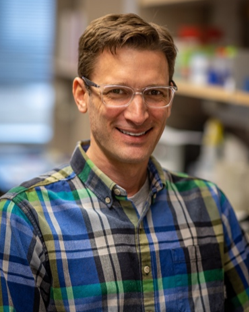Exciting Discoveries
Department of Immunology & Microbiology
We highlight research articles on our website to keep you informed about the latest advancements and exciting discoveries from our amazing scientists within the basic science departments at CU Anschutz Medical Campus.
By showcasing our cutting-edge research, we hope to spark curiosity, promote understanding, and inspire engagement with science and innovation. Our goal is to empower you with knowledge that can inform decision-making, foster critical thinking, and contribute to a better understanding of what we do here in the research labs at the University of Colorado Anschutz.
2025

Dr. Jared Klarquist and his research team study how vaccines trigger responses in a type of very important cells in the immune system called T cells. While there are many successful vaccines to combat a variety of infectious pathogens, most of them induce B cells (another very important type of immune cell) to produce antibodies, but may not induce robust responses by T cells.
The big question is, ‘what makes vaccines trigger powerful T cell responses?’
In order to figure this out, Jared and his team are on the hunt for factors that trigger and control T cell responses to vaccines. The answers they find may help scientists to develop more effective vaccines that would induce robust antibody production by B cells and robust cellular responses by T cells.
Dr. Jared Klarquist published a science article in April 2025 in the Journal of Clinical Investigation titled, ‘B cells shape naïve T cell programming.’
Before we dive into a summary of this research article, you might be wondering, ‘What’s the difference between a B cell response and a T cell response?’ Great question!
Start off by thinking about the immune system as the defense system for the body and infectious pathogens, like the influenza virus, as the enemy trying to invade and take over the body. In this scenario, when the body is invaded by the influenza virus, B cells in your body (that are specific for the influenza virus) start producing antibodies against influenza. Antibodies are Y-shaped protein ‘missiles’ that seek out and tag the pathogen of interest – in this case influenza – for destruction. At the same time, T cells in your body (that are specific for the influenza virus) become activated – or triggered – and either help other cells in the body get involved in the fight (these are called CD4+ helper T cells) or engage in hand-to-hand combat with the influenza-infected cells in your body to destroy them (these are called CD8+ killer T cells). Now that you’ve got an understanding of the difference between B cells and T cells, let’s learn more about Jared’s exciting discovery!
To gain a better understanding of the research in this article, please read the easy-to-understand summary below.
B cells shape naïve T cell programming
Have you ever had an encounter with someone who tried to rough you up on the playground? If so, you likely have that person burned into your memory so that if you see them again, you will immediately be ready to defend yourself from attack! Our immune cells – T cells and B cells – do the same thing! T cells and B cells make long-lasting memory cells against any pathogen they’ve encountered (whether it was through a vaccine or infection) over our lifetime to be ready to fight if it enters the body again.
Jared and his research team recently found an exciting discovery in the area of T cell memory.
They figured out B cells and T cells collaborate in unexpected ways; B cells play a role in helping CD8+ killer T cells that have responded to vaccines become long-lived memory cells.
In mouse models that lack B cells, they discovered that naïve (or never been activated) CD8+ T cells are unlikely to transition to memory cells. This significantly impacts their response to vaccination since long-lived memory cells are needed for protection against the pathogen if encountered again in the future. They also found that human patients without B cells (usually as a result of B cell depletion therapy for an autoimmune disease or cancer) are unable to make long-lived memory CD8+ T cells following COVID vaccination. Adding these research discoveries together, Jared and his team showed that B cells help naïve CD8+ T cells transition into memory cells after vaccination.
The bottom line is that B cells play a role in helping to maintain and enhance the T cell response! Their research showed that B cells help CD8+ killer T cells that have responded to vaccines become long-lived memory cells and B cells also seem to play a role in maintaining stable or homeostatic populations of naïve CD8+ killer T cells in the body.
The next phase of this exciting research will be to learn more about the collaboration between B cells and T cells. By learning more about this collaborative process and how vaccines trigger T cells to respond - Jared and his research team could harness what they’ve learned to create new and improved vaccines for preventing and treating diseases.
Dr. Rocky Lee Baker and his research team study the autoimmune disease Type 1 Diabetes (T1D). In particular, they study how a certain type of immune cell, called a CD4 T cell, gets activated in people who have T1D. They want to figure out how these normally protective CD4 T cells mistakenly attack and destroy the insulin-producing cells in the pancreas.
The big question is, ‘what makes these CD4 T cells go rogue and attack their own body?’
In order to figure this out, Rocky and his research team are working hard to discover new targets (the fancy science term is ‘neoantigens’) that these cells might be attacking. They are trying to find out if there is something that looks new and different and kind of suspicious on the insulin-producing cells in the pancreas of people who develop T1D that sounds the alarm and accidentally causes the immune system to attack.
To uncover these mysteries, they use a variety of scientific techniques to study CD4 T cells in both mice and humans with and without T1D. The scientific discoveries made in this lab could lead to the development of new and better ways to diagnose, monitor and treat T1D.
Dr. Rocky Baker published a science article in January 2025 in the journal of Diabetes titled, ‘Novel T Cell reactivities to Hybrid Insulin Peptides in Islet Autoantibody-Positive At-Risk Subjects.’
To gain a better understanding of the research in this article, please read the easy-to-understand summary below.
Novel T Cell reactivities to Hybrid Insulin Peptides in Islet Autoantibody-Positive At-Risk Subjects
Did you know that Type 1 Diabetes (T1D) is an autoimmune disease where the body’s immune system attacks its own insulin-producing cells? It’s true! Our insulin-producing cells are called beta cells and they are found in the organ in our body called the pancreas. People living with the autoimmune disease T1D no longer have insulin-producing beta cells due to their destruction by their own immune system.
You might be asking yourself, “Why does this happen? Why would the immune system attack and kill insulin-producing cells?” Well, you’re not alone! Dr. Rocky Baker and his research team have the same question!
Rocky’s research shows that certain immune cells, called CD4 T cells, target small pieces of the insulin protein called Hybrid Insulin Peptides or HIPs. These HIPs are formed in the pancreas from parts of insulin and other proteins. To learn more about the immune cells and their role in the development of T1D, they tested and compared the reactions of immune cells to 240 different HIPs from patients with T1D and healthy individuals. They discovered that the immune cells from T1D patients reacted strongly to HIPs formed at specific spots on the insulin protein. Another important finding came from testing another group of people who were at risk for developing T1D. They found that in these individuals that even before T1D symptoms appear, their immune cells exhibit strong reactions to HIPs.
This knowledge is very exciting as it could be used to improve early diagnosis of Type 1 Diabetes in people who do not yet have symptoms and possibly result in treatments that could delay the onset of T1D.
2024

Dr. Breck Duerkop and his research team study DNA segments that have the potential to move between bacteria called mobile genetic elements (MGE). A few examples of MGE are bacteriophage (viruses that infect bacteria), plasmids or tiny loops of DNA that bacteria share with each other (like passing notes in class), and insertion sequences or little pieces of DNA that can jump around inside a bacterium’s genetic material or genome (like microbe-sized cut-and-paste tools).
The Duerkop research team is especially interested in how the MGEs change the way bacteria behave and how these changes might influence how bacteria act in the human body. Breck and his team study MGEs in the community of helpful bacteria living in our bodies, called the microbiome. By learning more about how mobile genetic elements (MGE) work and alter the way bacteria behave, they hope to understand how they affect the balance between health and disease.
The big questions are, ‘how do MGEs change the way bacteria behave?’ and ‘how do these changes influence their behavior in the human body?
Drs. Breck Duerkop and Joshua Kirsch published a science article in May 2024 in the journal of Cell Host & Microbe titled, ‘A metagenomics pipeline reveals insertion sequence-driven evolution of the microbiota.’
To gain a better understanding of the research in this article, please read the easy-to-understand and creative summary below.
A metagenomics pipeline reveals insertion sequence-driven evolution of the microbiota
Think of your intestinal tract (aka ‘gut’) as an ever-changing community garden filled with many types of plants with each variety representing different species of bacteria and other microbes. Every person’s garden is unique, shaped by the “seeds” you start with (your early-life microbes), what you feed it, and the conditions it faces over time.
Now, imagine there aren’t just gardeners in this space, but also pollinators like bees, butterflies, and birds that fly in and out. These pollinators stand for mobile genetic elements (MGEs): viruses, plasmids, and genetic fragments able to move genetic information from one microbe to another. MGEs aren’t in charge of the garden, but their actions have far-reaching effects. Sometimes they help plants adapt or recover after a storm (like antibiotics or infection); other times, their visits bring trouble, like spreading disease or unwanted weeds. Their impact depends on timing, context, and whose perspective you take; a well-timed pollinator can rescue a wilting patch but might also introduce an invasive species.
Dr. Joshua Kirsch, a researcher in the laboratory of Dr. Breck Duerkop, developed a toolkit that works like a time-lapse diary and tracking system for your microbial garden. With it, scientists can see which pollinators arrived, what genetic “pollen” they left behind, and how the garden’s landscape changed as a result. This allows comparisons between gardens: Did a particular pollination event help a garden recover quickly after a storm? Was a certain invasive species kept in check, or did it overrun the rest? The toolkit can even record the story of past disruptions, giving a timeline for how the garden adapted.
Not every visit from these pollinators is good. Sometimes an MGEs’ actions help bacteria survive attacks from “pests” (such as viruses) which is great for the bacteria, but sometimes bad for us if we’re trying to use those viruses as therapy, as shown in Kirsch and Duerkop’s earlier study. Pollinators in the natural world can also spread blight; similarly, MGEs might drive the spread of undesirable traits or resistance to helpful treatments.
Kirsch and Duerkop’s work demonstrate that understanding these pollinators, not just who’s in the garden, but who’s sharing genes and why, is crucial for predicting how gardens thrive or falter, and for designing ways to support their health.
By closely tracking the pollinators and their influence, researchers hope to foresee how a person’s garden will respond to changes: a new diet, medicine, or infection. Someday, this insight could help doctors foster healthier inner gardens, tailoring therapies that encourage the right pollinators or block the harmful ones.
Dr. Alex Horswill and his research team study the social lives of bacteria and how they interact with the cells they infect. Alex and his team focus their research on a few different types of harmful bacteria; one particular type of bacteria they spend a lot of time studying is called Staphylococcus aureus or S. aureus for short. Scientists and medical doctors have found that some forms of S. aureus cause serious infection because they are resistant to antibiotics, the types of medicine that help the human body get rid of bacterial infections. The nickname for this type of particularly challenging form of S. aureus is methicillin-resistant Staphylococcus aureus (MRSA).
To unlock the secrets of how bacteria grow and cause disease, Alex and his research team use a variety of scientific techniques to study the basic components of life, such as genes and molecules. These techniques help them to investigate how these harmful bacteria communicate and coordinate their actions to infect and survive in host cells. The scientific discoveries made in this lab could lead to the development of new treatments that reduce the severity of infection or, even better, prevent infection from happening in the first place. This research has the potential to lead to better health outcomes through improvements in the way bacterial infections are diagnosed and treated.
Dr. Alex Horswill and Dr. Richard Gallo published a review article in May 2024 in the Journal of Investigative Dermatology titled, ‘Staphylococcus aureus: The Bug Behind the Itch in Atopic Dermatitis.’
To gain a better understanding of the research in this article, please read the easy-to-understand summary below.
Staphylococcus aureus: The Bug Behind the Itch in Atopic Dermatitis
Have you ever wondered why your skin itches? Whether it’s a pesky mosquito bite, a mysterious rash or a troubling skin condition, itching can be irritating. Atopic dermatitis is a skin condition that makes the skin feel itchy and uncomfortable. The reasons why itching happens are complicated. Scientists think that itching might be used by the body as a defense mechanism or a way to alert the body of outside invaders – like bacteria – that are trying to get into the body through the skin. Itching can also lead to inflammation, the movement of immune cells to the area of damage, and stress because no one likes itchy skin.
The good news is that scientists have made progress in understanding what causes itching in the skin! It turns out that the bacteria Staphylococcus aureus (S. aureus for short) makes a protein, called V8 protease, that causes itching by activating ‘itch’ receptors in the skin. People who have atopic dermatitis often have S. aureus growing in their skin, which might explain why itching of the affected areas of the skin is so common in people with the disease. By studying the science of itching skin, scientists have discovered how S. aureus contributes to itching. This knowledge could be used to improve treatments for atopic dermatitis and other conditions that cause itching in the skin.
2023
Dr. Kelly Doran and her research team study how certain types of bacteria interact with the human body, especially in the brain, the female reproductive system and diabetic wounds. The fancy scientific term for this type of research is ‘host-pathogen interaction.’
Kelly and her research team focus on a certain type of bacteria called Group B Streptococcus (GBS), which can cause serious illness in newborns and some adults, including pregnant women and diabetic patients with wounds.
To unlock the secrets of how these bacteria grow and cause disease, Kelly and her research team use a variety of scientific techniques to study how GBS infects cells and how the body fights back. These techniques help them to investigate how these harmful bacteria survive in host cells. The scientific discoveries made in this lab could lead to the development of new treatments that reduce the severity of infection or, even better, prevent infection from happening in the first place. This research has the potential to lead to better health outcomes through improvements in the way bacterial infections are treated.
Dr. Kelly Doran and her team published a science article in June 2023 in the American Society for Microbiology journal, mBio, titled, ‘The impact of nutritional immunity on Group B streptococcal pathogenesis during wound infection.’
To gain a better understanding of the research in this article, please read the easy-to-understand summary below.
The impact of nutritional immunity on Group B streptococcal pathogenesis during wound infection
Do you remember the last time you skinned your knee? Maybe you were riding a bike, playing a game of tag or just tripped over a bump in the sidewalk. No matter how it happened, most of us have experienced a skinned knee. As we cleaned the wound and put on a band-aid, our bodies were already at work eliminating germs and healing the wound. For some people though, like people who have diabetes, this process may not be as quick compared to people who are healthy and do not have diabetes.
Kelly and her lab are fascinated by this finding and study the process of how germs influence the healing process. They are on a quest to figure out why is wound healing is different between mice with diabetes compared to mice without diabetes. This type of research could lead to the discovery of treatments that speed up the wound healing process in patients with diabetes.
The members of the Doran research lab are microbiologists or scientists who study a certain type of microorganism called bacteria, which are teeny, tiny organisms that we can only see under a microscope. Depending on the type of bacteria, they can sometimes make us sick. Group B Streptococcus (GBS) is a type of bacteria that can cause health problems in newborns and vulnerable adults. It’s also often found in wounds of people with diabetes but rarely in those without diabetes.
Kelly and her research team made a diabetic mouse model to study the role of GBS in wounds, which was published as a Science article in November 2022 in the Science Advances journal titled, “Group B Streptococcus adaptation promotes survival in a hyperinflammatory diabetic wound environment.” They found that certain genes related to the transport of metal ions, which are important to certain cellular functions, were more active (or turned ‘on’) in diabetic wounds. Because of this exciting discovery, they continued to study what this would mean for the bacteria and wound healing. They found out that a protein called calprotectin (CP) is found in higher levels in diabetic wounds compared to non-diabetic wounds. CP is a metal chelator, which means that its job is to take in and use metal ions to help the cell function. When CP does its job and takes in metal ions in the environment of a wound, it helps to prevent bacteria like GBS from using metal ions to grow and survive. It’s basically competition for limited resources, like metal ions, between the cells in the wound and the bacteria trying to live there. If all is well, this metal ion ‘competition’ helps the cells in the wound to heal and prevents the bacteria in the wound from surviving.
Surprisingly, the scientists discovered that CP was really good at helping to control GBS in the wounds of mice without diabetes but that it did not help control GBS in the wounds of mice with diabetes. This discovery tells us that CP by itself is unable to control bacterial infection in diabetic wounds. By studying the science of wound healing in diabetic mice, Kelly and her team are getting closer to figuring out what does – and does not – contribute to wound healing in diabetes.
This research is important because diabetic wound infections are hard to treat and often become chronic or long-lasting. GBS in particular is a common and deadly bacteria in diabetic wounds. The good news is better understanding of why GBS is able to thrive in diabetic wounds could lead to improved treatments and faster healing.

Dr. Brian Russo and his research team study the secret lives of bacteria and how they hijack the cells in our gut. They focus on a certain type of bacteria called Shigella flexneri, which infects the cells in the colon and causes diarrhea in humans. This bacteria invades cells in the colon and spreads between them to cause more infection. It uses a special syringe-like tool (called a type 3 secretion system) to inject its bacterial proteins into the cells it infects to hijack and take over the cell. These injected proteins, known as effector proteins, change the cell's normal functions and shift it away from helping the cell survive to helping the bacteria survive in its new home – the colon cell it just invaded.
Brian and his research team are dedicated to learning how Shigella flexneri hijacks the cells of the colon to better understand the infection process. The information they learn could lead to the development of new treatments that reduce the severity of infection or, even better, stop the spread of infection completely. Overall, this research has the potential to lead to better health outcomes for many people through improvements in the way bacterial infections are diagnosed and treated.
Dr. Brian Russo and his research team published a pre-print of an article in bioRxiv in April 2023 titled, ‘Synaptopodin is necessary for Shigella flexneri intracellular spread,’ while waiting for peer review and acceptance into a journal.
To gain a better understanding of the research in this article, please read the easy-to-understand summary below.
Synaptopodin is necessary for Shigella flexneri intracellular spread
Have you ever wondered how bacteria get into our cells and cause infection? Dr. Brian Russo has the same question! His research focuses on howa certain type of bacteria called Shigella flexneri, hijack the cells in our gut. For bacteria to be successful, they need to be able to infect their host and spread from cell-to-cell to cause more infection. The Russo research team discovered that some bacteria use a type of ‘forced entry’ to infect the cell next door. The bacteria do this by pushing out part of the membrane of the cell it currently has taken over or infected and force the cell next door to take it in. You can think of this like an apartment building where there are lots of cells living side-by-side. Now imagine the bacteria that lives in cell #1 pushes itself – along with a piece of the wall – into cell #2 and then takes over living in cell #2. This is exactly what happens with the bacteria Shigella flexneri! It pushes itself from the cell it’s living in (cell #1) into the neighboring cell (cell #2) so that it can spread from cell to cell and eventually take over the whole apartment building. In the human body, it does this within the cells in the colon or large intestine.
In this paper, Brian and his research team discovered that a protein in mammals called synaptopodin is important for this ‘forced entry’ process to invade neighboring cells. They figured out that synaptopodin gathers around another protein called actin. These proteins and a special injection system (called type 3 secretion system) all work together to invade the neighboring cells. By working on these research questions, the Russo team learned more about how the infection process works in the type of bacteria called Shigella flexneri. This knowledge very is important as it could lead to new and better treatments for bacterial infection and human disease.
2022
Dr. Curtis Henry studies how elevated fat levels in the body play a role in the progression of cancer and treatment responses to certain cancer drugs, specifically chemotherapies and immunotherapies. Chemotherapy treatments kill fast-growing cells and immunotherapy treatments harness the body’s own defense system – the immune system – to kill cancer cells. Curtis and his team are on a quest to learn how fat influences cancer cells and their detection by the immune system. His research will be used to create new and unique cancer drugs for patients with poor survival outcomes.
More information about Curtis's research can be found on X (Twitter) @Immunology4Life
Dr. Curtis Henry and his team published a science article in the journal of Nature Communications in March 2022 titled, ‘Obesity-induced galectin-9 is a therapeutic target in B cell acute lymphoblastic leukemia.’
To gain a better understanding of the research in this article, please read the easy-to-understand summary below.
Obesity-induced galectin-9 is a therapeutic target in B cell acute lymphoblastic leukemia
The number of people living with obesity (or high levels of fat cells in their bodies) are increasing across the globe. This is concerning because obesity raises the risk of death in people with different types of cancer, including leukemia. We think the difference in survival rates between lean and obese patients with cancer is because cancer drugs work differently in lean and obese bodies, with their effect decreasing or not working as well in patients with high numbers of fat cells. When making cancer drugs, we don't usually think about how the interactions between cancer cells and other cells in the body, like fat cells, influence drug-induced cancer cell death. Curtis and his team found that molecules released by fat cells make leukemia cells more resistant to cancer drugs called chemotherapy by increasing the production of a specific protein called Galectin-9 (GAL-9). They also found that when they target GAL-9 in mouse leukemia cells with special proteins made by the immune system called antibodies, the cancer cells' DNA is damaged, which disrupts their growth and triggers cell death. Furthermore, they demonstrated that this treatment – antibodies that target GAL-9 – significantly prolongs survival in obese mice with aggressive leukemia. The findings from Henry’s research suggests that therapies, like antibodies, targeting GAL-9 could help overcome chemotherapy resistance caused by obesity-related factors in leukemia patients. Because of the positive results of this research in mice, this treatment strategy is currently being tested in a Phase I clinical trial in patients with aggressive disease.

2021

Dr. Kyla Ost studies a specific type of fungus called Candida albicans. Fungi are found in the gastrointestinal tract or gut of most humans, and most of the time do not cause any harm. However, sometimes if the immune system – the bodies built-in defense system – is out of balance, the fungi in our gut can cause harm by promoting inflammation. Kyla is working hard to learn how the immune system keeps this fungus, Candida albicans, from causing harm in our bodies, particularly our gut.
More information about Kyla's research can be found on her lab's website here.
Dr. Ost and her team published a science article in the journal of Nature in July 2021 titled, ‘Adaptive immunity induces mutation between commensal eukaryotes.’
To gain a better understanding of the research in this article, please read the easy-to-understand summary below.
Adaptive immunity induces mutualism between commensal eukaryotes
There are fungi living peacefully in our gut called ‘commensal organisms’ that help train the body’s defense system – the immune system. But sometimes these peaceful or commensal organisms can take on new forms that make us sick or make certain inflammatory bowel diseases, like ulcerative colitis and Crohn’s disease, worse. We don’t fully understand how these fungi and the immune system interact in the gut. Kyla studies this fungi-immune system interaction and discovered that certain forms of Candida can cause more harm because they are better at sticking to and invading the gut wall. In the gut, this more harmful form of Candida triggers a response from a special ‘weapon’ in our immune system’s arsenal called immunoglobulin A (IgA), which prevents it from causing harm. By fighting against this more harmful form of Candida, our immune system actually makes it harder for the harmful form of the fungus to survive there. This finding is important for people who have intestinal colitis since the harmful form of Candida often makes their disease worse. To learn even more about how we could help our immune systems keep our gut healthy, Kyla tested out a vaccine in mice that trained the immune system to fight the more harmful form of the Candida. She found that the vaccine protected the mice who had intestinal colitis from getting sick from Candida during their illness. Overall, Kyla’s research shows that the body’s defense system keeps the more harmful versions of the Candida fungi in check and that the special immune system ‘weapon’ called IgA plays a big role in preventing the more harmful forms of Candida from causing harm while allowing the more agreeable forms of Candida to live in our bodies peacefully.

Dr. Jenna Guthmiller studies how the immune system – the body's built-in defense system – responds to the influenza (flu) virus and how the flu virus itself plays a role in controlling the immune response. She is on a mission to learn how scientists can design better and more protective flu vaccines for the future. In particular, she is interested in figuring out how to make flu vaccines that would provide protection against a wide range of influenza virus strains at the same time and possibly result in the development of one ‘universal’ flu vaccine.
More information about Jenna's research on her lab's website here.
Dr. Guthmiller and her team published a science article about her research in the journal of Nature in December 2021 titled, ‘Broadly neutralizing antibodies target a hemagglutinin anchor epitope.’
To gain a better understanding of the research in this article, please read the summary below.
Broadly neutralizing antibodies target a hemagglutinin anchor epitope
Have you ever wondered if it would be possible to make a flu vaccine that could be protective over several years? Dr. Jenna Guthmiller has the same question! New findings from her research focused on the immune response to the influenza virus suggest that there may be potential for the creation of a multi-year or universal vaccine. Like all viruses, the influenza virus is good at hiding from the immune system by changing what it looks like every year. You can think of the influenza virus as wearing a coat and each year it changes the color of the coat to throw off the detection of the immune system. If one year the coat on the virus is red, the next year the coat on the virus is orange. The constantly changing color of the coat makes it hard for the immune system to detect the invader. If the immune system has been trained and is ready to attack the virus wearing a red coat, the new viruses wearing orange coats slip by undetected.